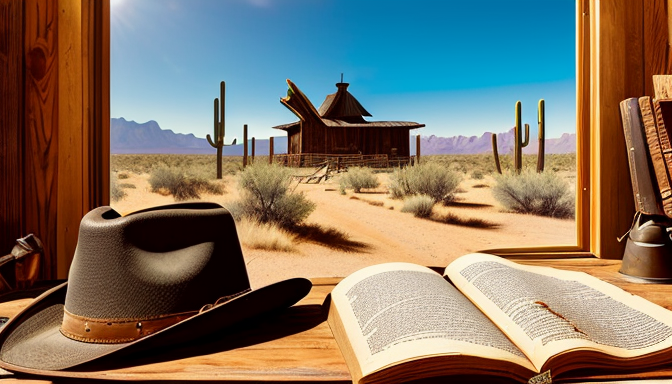The Western genre has always been a captivating reflection of the American spirit, a bold exploration of freedom, adventure, and the rugged frontier. From the dusty trails of cowboys to the dramatic confrontations in saloons, these stories have evolved from the pages of novels to the bright lights of cinema. Have you ever wondered how these iconic tales transitioned from ink to film? It’s a journey filled with passion, creativity, and a touch of nostalgia.
At the heart of these legendary narratives are authors like Zane Grey and Louis L’Amour, whose gripping tales laid the groundwork for the genre. Their vivid descriptions and unforgettable characters painted a picture of the Wild West that filmmakers later sought to capture on screen. Imagine reading about a lone gunslinger facing off against a notorious outlaw, only to see that scene come to life with all the dust and grit of the era. This transformation not only brought these stories to a wider audience but also reshaped the cultural landscape of America.
As we explore the cinematic adaptations of these literary masterpieces, we see how directors interpreted the essence of the West. Films like “True Grit” and “The Good, the Bad and the Ugly” have become staples, showcasing how the themes of justice, revenge, and survival resonate across generations. Each adaptation offers a unique lens through which we can view the complexities of human nature against the backdrop of the untamed frontier.
The Evolution of Western Literature
When we think of the Western genre, images of rugged cowboys, expansive landscapes, and thrilling shootouts come to mind. But where did it all begin? The roots of Western stories can be traced back to the early American frontier, where tales of adventure and survival were born. Pioneering authors like Owen Wister and Louis L’Amour crafted narratives that not only entertained but also captured the spirit of a nation in the making. Their works laid the groundwork for a genre that would evolve dramatically over the years.
These literary giants introduced us to iconic characters and themes that resonate even today. From the noble sheriff to the outlaw on the run, these figures embody the struggle between law and chaos, civilization and wilderness. The Western genre often reflects the American Dream, showcasing the pursuit of freedom and the quest for identity. As readers, we are drawn into a world where every dusty trail leads to a new adventure, and every sunset hints at the promise of a better tomorrow.
Moreover, the evolution of Western literature is not just about individual authors; it’s about the collective storytelling that has shaped our understanding of the frontier. Folktales, ballads, and myths contributed to a rich tapestry of narratives that defined the American experience. As we explore these stories, we see how they’ve transitioned from the pages of books to the silver screen, paving the way for unforgettable cinematic masterpieces that continue to captivate audiences worldwide.

Iconic Film Adaptations
The transition from page to screen has truly redefined iconic Western stories, bringing the rugged landscapes and complex characters of the frontier to life in ways that literature alone could only hint at. Think about it—when you hear the crack of a gun or see the dust swirl in a high noon showdown, it’s hard not to feel that rush of adrenaline! Films like “The Searchers” and “Unforgiven” have not only captured the essence of the narrative but have also added layers of depth and emotion that resonate with audiences even today.
These adaptations often take the original text and transform it, emphasizing different themes or character arcs. For example, John Ford’s adaptation of “The Searchers” delves into themes of racism and revenge, which were subtly present in the novel but explode into the forefront on screen. This shift not only honors the source material but also invites viewers to engage with the story on a more profound level. The emotional weight of the characters is amplified through powerful performances, stunning cinematography, and evocative score, making the films unforgettable.
Moreover, these cinematic retellings have left a lasting impact on American culture, shaping the way we view the mythos of the Wild West. They have paved the way for a new generation of filmmakers and writers to explore the genre, ensuring that the legacy of Western stories continues to thrive. In essence, the journey from literature to film is not just a transition; it’s a reimagining of how we perceive the frontier and its tales.
Frequently Asked Questions
- What are some classic Western stories that have been adapted into films?
Many legendary Western stories have made their way to the silver screen! Think about titles like “True Grit” and “The Searchers”. These adaptations not only brought the tales to life but also introduced a new audience to the rich narratives of the Wild West.
- How did Western literature influence modern cinema?
Western literature laid the groundwork for storytelling in film, creating archetypes and themes that filmmakers still use today. The struggle between good and evil, the rugged individualism of heroes, and the portrayal of vast landscapes are just a few elements that continue to resonate in modern movies.
- Who are the key authors in Western literature?
Some of the most influential authors include Zane Grey and Louis L’Amour. Their works not only defined the genre but also inspired countless adaptations, making them pivotal figures in the evolution of Western storytelling.
- What makes a good Western film adaptation?
A great Western film adaptation captures the essence of the original story while bringing a fresh perspective. It should respect the source material but also engage viewers through stunning visuals and compelling character development.